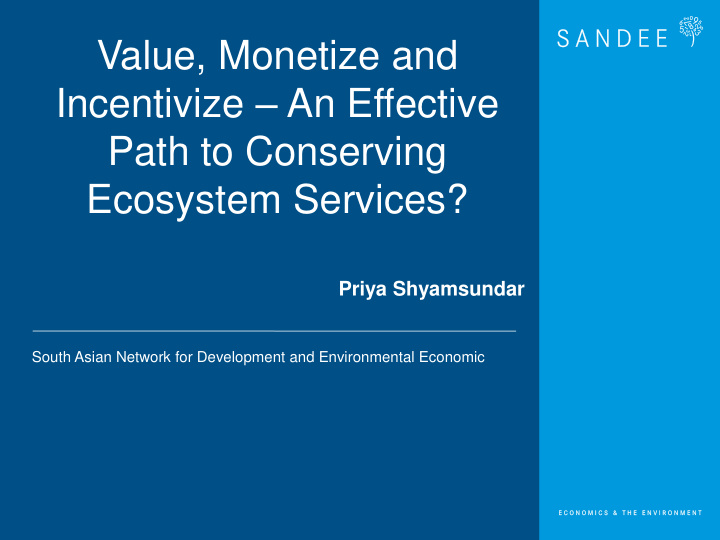



Value, Monetize and Incentivize – An Effective Path to Conserving Ecosystem Services? Priya Shyamsundar South Asian Network for Development and Environmental Economic
Wealth Estimates (World Bank) Wealth Per Capita 18000 16000 14000 12000 1995 10000 8000 2000 6000 2005 Natural Capital - % of Total 4000 2000 1.5 0 1.4 1.3 Bhutan Nepal India 1.2 1.1 1 0.9 0.8 0.7 0.6 1995 0.5 0.4 2000 0.3 0.2 0.1 2005 0
What about Ecosystems as Natural Capital?
Lessons from Reviews • Provisioning versus Regulating Services • Limited links to trade-offs & human impacts • Distribution un-even • Valuation disconnected from policies • Limited evidence of impacts of PES • Should payments be equity neutral? Creating win-wins from trade-offs? Ecosystem services for human well-being: A meta-analysis of ecosystem service trade-offs and synergies in the real world, Global Environmental Change, Vol 28, 2014, 263-275
Case Studies Payments to reduce Payments for Storing Black Carbon Carbon, Bishnu emissions, Krishna Sharma Pant
Residue Burning across South Asia Black carbon • 2 nd biggest contributor to global warming • Health threat • 40% of global levels from India and China • 24% from open K.P. Pant field burning in India
Crop Residue Practices across South Asia India - Combine (% land) Pakistan (% land) Used Used 27% 30% Fully Fully Burnt Burnt 57% Partial Partial 58% Burnt Burnt 16% 12% Bangladesh (% plots) Nepal (% households) Fully Burnt Other 3% 4% Partial Burnt Used 39% Fully 58% Burnt 96% Z. Haider, R. Gupta, Ahmed and Ahmad, K.P. Pant, SANDEE Working papers
Can we compensate farmers to reduce a public bad? 20 mil tons of crop residue Other Work 3% Easy 13% Fertilit Combine H . ban in-effective Plow y 21% Easy 63% KP Pant. Monetary Incentives to Reduce Open-Field Rice-Straw Burning in the Plains of Nepal. Res and Env Econ 2014
Reverse Auction – Accept Payments to Conserve • Baseline (n=317) • Bidding Top as • Agreements (53%) Feed Incorpo 31% rated • Recording Plots 41% • Monitoring and Verification Compo • Payments (86%) st 28% Post Agreement (% farmers)
Lessons to Solutions Incentives Payments Possible Work Necessary Solutions Private Median Rights payment and $78/ha Costs Reduce 86 % Public Compliant Bad
Will Payments with Local Monitoring Work? • Deforestation and degradation ~ 17% of GHG emissions • REDD+ -- market based, quick, cheap • Will carbon sequestration through community forests be effective, cost efficient, Bishnu equitable? Sharma Sharma, B, M. Nepal, S. Pattanayak, B. P.Shyamsundar, B. Karki 2014
ICIMOD - FECOFUN - ANSAB Pilot • National Trust Fund • Payments = f (Carbon+ Δ in Carbon + % Indigenous, Dalits, Women, Poor) • Guidelines on forest and livelihood enhancement Three Landscapes • MRV
Strategy to Assess Impacts Indicators Matched Baseline Forest / Controls Carbon Comm DID Socio- Impact unity Economic Forests End line Institutional REDD+
Change in Forest Indicators Ecological Impacts variables Carbon Per Hectare (All Districts) Forest fire (-)*** 250 254 249 . Grass cover (%) (+)** 225 221 200 FW collect signs (+)** Timber extract (-)** 150 Encroachments (-)*** 100 Wildlife signs (+)*** 50 0 Base line End line Base line End line REDD + CONTROL
REDD+ -- No Harm to Local Communities 5 -6% increase in Forest Impact Biogas Use Product Extraction (load) Firewood (~) Fodder-grass (~) Leaf-litter (~) Bishnu Sharma
Learning from the REDD+ Pilot Carbon neutral Trade-offs among services can be limited Shift to alternate fuels important
Observations • Incentives work • Connect the Δ in dots – services (measures), welfare (value), institutions and policy • Institutional costs matter • Integrating ecosystems into national accounts?
Acknowledgements and References • Ahmed, T. and Ahmad, B. ( 2013) .Why do farmers burn residue? : Examining Thanks to: farmers’ choices in Punjab, Pakistan . South Asian Network for Development and Environmental Economics (SANDEE), Working Paper, 76 – 13 • Ferraro, P.J. & K. Lawlor & K. L. Mullan & S. K. Pattanayak. Forest Figures: Ecosystem Services, Valuation and Policy Evaluation in Developing Countries, Rucha Ghate Review of Environmental Economics and Policy, 2012. • Anu Kafley Gupta, R.(2012). Causes of emissions from agricultural burning in North-West India: Evaluation of a technology policy response . SANDEE, Working Paper , Mani Nepal 66-12 • Haider, M. Z. (2013). Determinants of rice residue burning in the field . Journal Krishna Pant of environmental management, 128, 15-21 • C. Howe, H. Suich, B. Vira, G.M. Mace. Creating win-wins from trade-offs? Rajesh Rai Ecosystem services for human well-being: A meta-analysis of ecosystem Bishnu Sharma service trade-offs and synergies in the real world, Global Environmental Change , 2014. Jamuna Shreshta • A. P. Kinzig, C. Perrings, F. S. Chapin III, S. Polasky, V. K. Smith, D. Tilman, B. L. Turner II . Paying for Ecosystem Services: Promise and Peril, Science , Policy Forum, 2012. • S. Lele, O. Springate-Baginski, R. Lakerveld, D. Deb, P. Dash Ecosystem Services: Origins, Contributions, Pitfalls, and Alternatives, Conservation and Society, 2013 • MOEF, 2012. Economics of Ecosystem Services and Biodiversity: India, Initial Assessment and Scoping Report, MOEF Report, GoI • Pant, K. P. (2014). Uniform-Price Reverse Auction for Estimating the Costs of Reducing Open-Field Burning of Rice Residue in Nepal. Environmental and Resource Economics , 1-15.
Value, Monetize and Incentivize • Valuation first step toward conservation – Supply, Use, Institutional framework – Choice of method • Ecosystem services – Measurement w/o welfare changes of limited use – Transactions costs significant in design/implementation • National Ecosystem Accounts
Recommend
More recommend